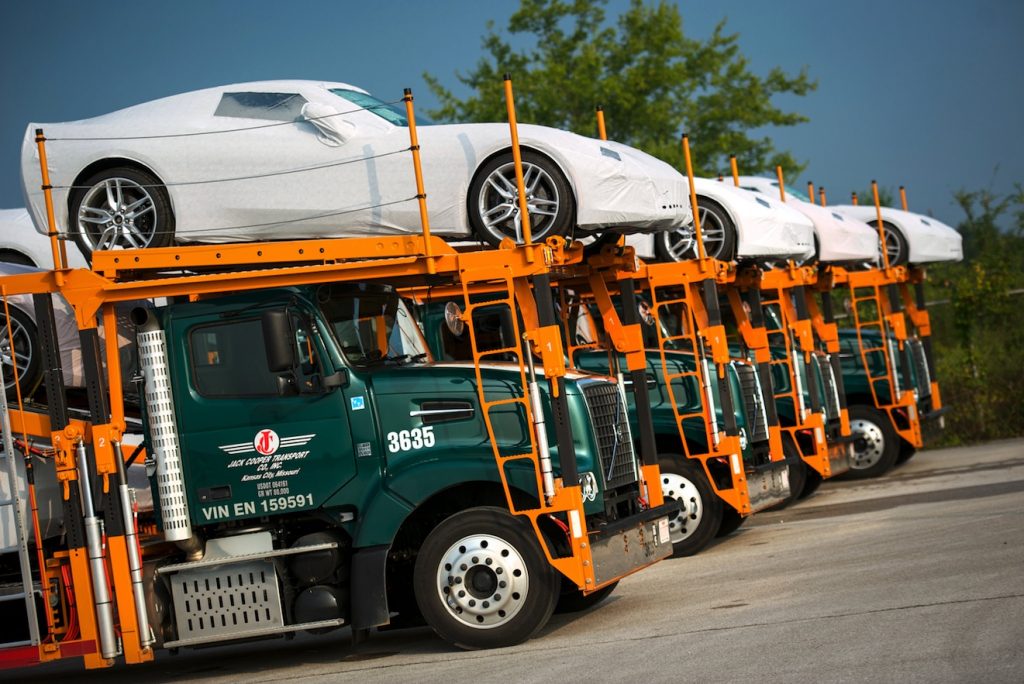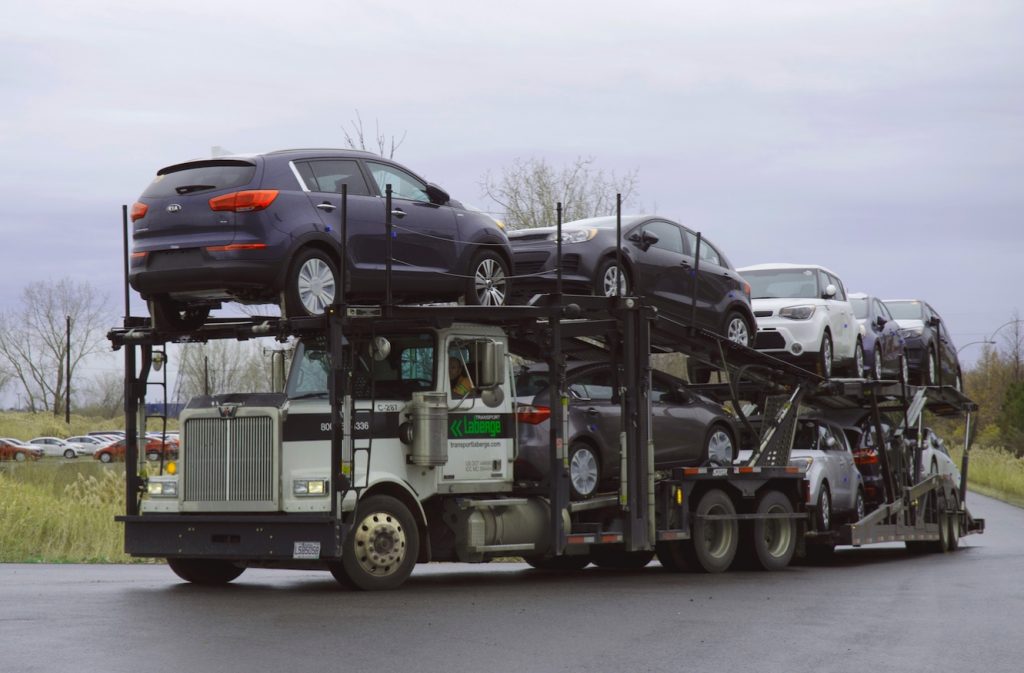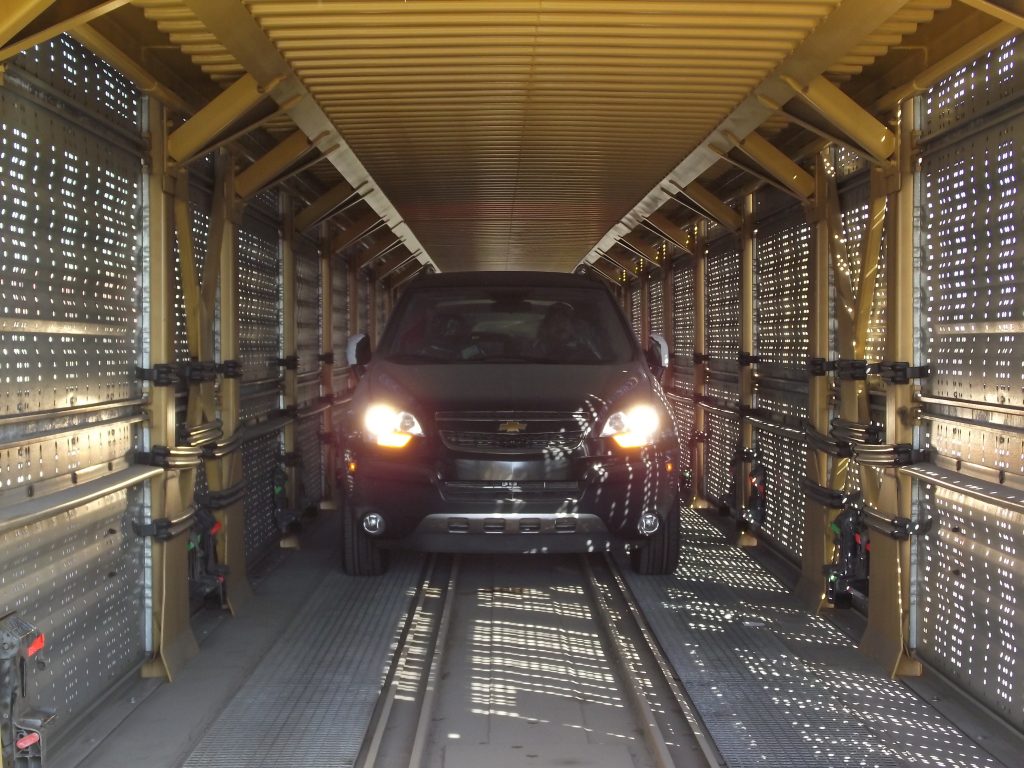 Though it has been around for a while, the vehicle logistics world is only just beginning to catch on to the potential of ePOD, especially in North America, where mandates and standards are setting the course
Though it has been around for a while, the vehicle logistics world is only just beginning to catch on to the potential of ePOD, especially in North America, where mandates and standards are setting the course
Paperless transactions have been ubiquitous in the transfer of goods and services for more than a generation: just think of the digital pen you often use to sign for an express delivery to your home. However, the adoption rate in the automotive supply chain, and especially finished vehicle logistics, varies widely. It often depends on the country, OEM, carrier, available technology, or differing regulations – although in general, the outbound sector cannot be said to be ahead of the game. However, though electronic proof of delivery (ePOD) has been in use for more than two decades at various points in the sector, interest and use has spread over the past two years. Several OEMs have now mandated carriers to implement the technology, and the sector has begun to agree to wider standards.
In 2014, Chrysler Group (today, Fiat Chrysler Automobiles) took the lead in North America by ensuring all of its road carriers use ePOD. General Motors followed with the same requirements shortly thereafter and into 2015. According to executives from carriers and IT companies, these mandates have improved the structure of the vehicle delivery process, or at least the end of it, and have provided incentives for carriers and shippers to offer leaner logistics services.
GM is now using ePOD technology for new vehicles moved by road from vehicle distribution centres (VDCs) and assembly plants to dealers, says Bryan Burkhardt, GM’s director for North American vehicle logistics. The technology is not altogether new for GM – one of its service providers had been using ePOD for several years, for example – however, other carriers have been adopting it since the requirements began. “As new haulaway service providers are added to GM’s network, if they are not currently using ePOD, we establish a timeline for rollout and implementation and then track it to completion,” Burkhardt explains.
For GM, ePOD technology has taken two forms. “The most common form is an app on the driver’s phone. The other form is a separate hand-held tablet,” says Burkhardt. “We also see two types of ePOD technology – either developed in-house by the carrier or developed through a third-party company.”

ePOD’s advantages include real-time data capture and reporting of final delivery using cloud technology. It provides proof of delivery and photo evidence of a vehicle’s condition, which for carriers is often the trigger to issue an invoice, and thus get paid quicker than waiting for filing paperwork. Dealers receive a clean PDF copy of the delivery receipt, which they can then maintain in their system or distribute as needed. Furthermore, the technology allows the driver to take photographs and capture exceptions and damages by vehicle identification number (VIN).
The technology has enabled many of GM’s carriers to improve dispatch and delivery information. Using a handheld device or tablet, the driver is able to report movements electronically. Burkhardt says this has helped to reduce reporting delays that many haulaway providers experienced before using ePOD.
“Often, the carrier entered dispatch and delivery information manually, either after the driver called into the dispatcher or when the driver returned to the terminal with the paperwork. The ePOD technology for many of GM’s carriers allows the driver to transmit the necessary update from the app or tablet directly into the carrier’s system. It also helps to reduce the dealers’ paperwork,” says Burkhardt.
As FCA has also reported, GM has seen improvements in the timing and accuracy of reporting from several carriers thanks to using ePOD. The quicker delivery notification compared to paper-based systems enables the carmaker to transfer inventory to dealers faster, and for carriers to receive payment sooner. The elimination of paper delivery receipts also enables cost savings on forms and document handling. Burkhardt emphasises that GM’s use of ePOD is still new, and with feedback from its carriers and dealers, it will continue to improve and evolve over time.
A story of standards and slow burn
While ePOD is currently being used mostly in the very end stage of delivery in recording dealer handoffs, its benefits may accumulate as it is used widely across the supply chain to record and manage events in real time. To get to this stage, however, supply chain stakeholders would benefit from working across the same standards and protocols. In the US, efforts are underway to agree a common set of industry standards.
This, too, is a process that has stretched back several years. Bill Kerrigan, who is today vice-president of logistics at SSA Marine, has played a key role in developing ePOD standards under the auspices of the AIAG (Automotive Industry Action Group). Kerrigan and the AIAG initially started the process as far back as before the global financial crisis in 2008, after which point the project was shelved. However, it has regained momentum in the last few years, with several phases already published.
Phase one focused on final delivery to the dealer. “We needed to determine what would go into the handheld device to make the data complete and secure the business rules. Carriers can snap on an ePOD TMS (transport management system) to a smart phone or scanner,” says Kerrigan.
Phase two, which began in 2014, focused on delivery to and from railheads. “We needed to provide process mapping from the plant, to the railhead, and on to the dealer,” he adds.
Lang Ware, director of supply chain products and services at AIAG, says the group is currently wrapping up the stakeholder review for phase two. “Some railroads are in compliance whereas others are in waiting,” Kerrigan adds.
Phase three will focus on the import and export of vehicles through ports, which Kerrigan says is the most complicated as it involves customs, border protection, and the most security. This phase is expected to be complete later this year.
While there has been clear progress for ePOD’s rollout in North America, the spread of the technology across the vehicle logistics sector has been slower than some would like. Wayne Pollock, managing director of ePOD and software-provider Car Delivery Network (CDN), says that uptake among other OEMs is still slow.
“Few OEMs see the value of ePOD technology except for FCA and GM,” he says. “Toyota is starting to, so that means ePOD’s value is growing. For the last two years, we have been informing the US about ePOD.
“The whole process is a slow burn,” he adds. “Not only is CDN used for FCA deliveries to the dealerships, but also for second-hand Chryslers to auction.”
CDN’s system emulates drivers’ delivery processes; it stores all data in the cloud and sends proof of delivery documentation to dealerships and notifies OEMs of a vehicle’s delivery. CDN began offering ePOD services in mid-2014 when FCA started rolling out its ePOD requirements in the US and Canada.
Even where manufacturers have required ePOD’s use, it hasn’t all been plain sailing. Initial reluctance by some dealers was one of the challenges GM faced when first implementing ePOD.
“Early on, we saw some hesitation from dealers as ePOD began to roll out,” says Burkhardt. “Paper delivery receipts were so entrenched with their daily process that when drivers started to arrive with a handheld device, some dealers did not know what to do. Although we started to communicate about ePOD technology before the rollout, it did not always mean that the person responsible for receiving vehicles at the dealer was aware of the programme.”
To ensure dealers were aware, GM worked with its sales organisation to provide information to carriers about implementation, use and benefits. Carriers also had to be educated about the benefits of ePOD, and it took some time to get everyone on board, though Burkhardt believes that most carriers now understand why the technology is also valuable to them.
The driver may also occasionally struggle to connect to the carrier’s system or network, which can happen because of signal or IT problems. In these cases, the outages require the driver to revert back to paper temporarily. It can also be difficult when a new carrier is brought into the GM network, so the carmaker must work carefully with each new provider on its rollout.
Carriers get connected
Thanks to GM and FCA’s market share, around a third of the market in North America is now using or set to use ePOD, at least for their final delivery to dealers. A number of carriers use ePOD voluntarily across their services, including Jack Cooper, North America’s largest road carrier.
 Jack Cooper released its ePOD technology in late 2013. All of its US terminals and the majority of its Canadian terminals are essentially 100% compliant.
Jack Cooper released its ePOD technology in late 2013. All of its US terminals and the majority of its Canadian terminals are essentially 100% compliant.Other carriers are either not required to use the technology, or not ready. After standards are implemented, this figure will likely rise further. The most common alternative is for the carrier to use its own system. “The industry standards for ePOD are fairly standard whether you use your own or outsource it, but the way you execute it is not,” says Greg May, president and chief executive officer of CDN.
Jack Cooper released its ePOD technology in late 2013. All of its US terminals and the majority of its Canadian terminals are essentially 100% compliant, according to Alex Meza, chief commercial officer for Jack Cooper Holdings. It uses Android-based tablets as its hardware.
“Our objective is to provide accurate and timely information to our customers and to ourselves. ePOD eliminates redundant efforts, increases driver satisfaction and productivity, assists fleet optimisation, and increases communication for all parties,” Meza says.
Those using the digital technology no longer have to wait for the driver to call or report to the terminal or deliver paperwork by hand. “Our ePOD application is responsive, which means that it can adapt to various device specifications, most notable being screen size,” says Meza. “Our app is probably more flexible than what we actually need. We focus on a consistent driver experience and that starts with the device itself.”
Jack Cooper is continuing to enhance its ePOD app by making smaller changes more regularly. This has proven to be less disruptive than a few large releases a year. Meza adds that AIAG’s work towards ePOD standardisation will be beneficial.
LaBerge Transport, based in Québec, Canada, uses a Microsoft Windows mobile platform and a Motorola MC65 handheld device. Serving eastern Canada and New Jersey, it handles 150,000 new vehicles annually for various OEMs, including GM, Toyota, Kia, Hyundai, and FCA, according to Nunzio de Pasquale, general manager. “We use ePOD technology for deliveries from plants and railheads to dealerships, ports, and in-transit yards,” he says. “It facilitates dealer inspection. If there are exceptions, we take photos and enter a North American universal code on the mobile device, which saves time for the driver and dispatcher compared to paper documentation,” he says.
According to Pollock, the largest carrier to use its technology is Hansen & Adkins. The California-based carrier currently has a fleet of around 1,000 trucks.
One of CDN’s most recent improvements to complement ePOD is an electronic gate exit application for use at rail facilities. Burkhardt says GM is currently working with AIAG to utilise this ePOD technology upstream in the supply chain to establish and finalise the process for paperless yard exits from VDCs.
 LaBerge Transport, based in Québec, Canada, uses a Microsoft Windows mobile platform and a Motorola MC65 handheld device.
LaBerge Transport, based in Québec, Canada, uses a Microsoft Windows mobile platform and a Motorola MC65 handheld device.CDN is also working with a large carrier on a single pane of glass system, in which ePOD technology is one function. “The US government will be requiring eHOS (Electronic Hours of Service) beginning in 2017, so we hope to incorporate that into our single pane,” explains Pollock.
Tracking claims
One of the key benefits of ePOD is in tracking and managing damage claims, since documentation, images and other details can all be loaded to the cloud. Damage claims and inspection providers are thus keen on increasing use of the technology.
Mark Morgan, director of business development at global inspection specialist UniCar, says his company has vehicle visibility within the supply chain as a by-product of collecting electronic vehicle data, which is essentially a free service for those who mandate vehicle inspection at handover points. UniCar is constantly updating its technologies to improve operational effectiveness and improve the use of the collected data for reporting and general analytics into the quality of handling in the supply chain. It is one element within a potentially very long process.
“ePOD technology appears to be another element that has grown out of a specific need to capture the ‘final mile’ delivery confirmation electronically, to modernise the final handover process that typically triggers the release of funds back to the manufacturer,” says Morgan. “There is also functionality available that can identify the condition of the vehicle, although this is a secondary aim, which is not always used in support of managing dealer claims outcomes.
“The problem is that everyone is doing this in isolation, and there is a lack of strategic thinking about how all these elements could be brought together,” adds Morgan. “Common standards are also essential to enabling such consolidation across operators and brands and the joint AIAG/ECG (Association of European Vehicle Logistics) initiative on quality standards is an example of the level of collaboration that would be needed to generate the ultimate aim of a single view of a vehicle throughout the supply chain.”
For Fenkell Automotive Services, a US-based claims specialist, the main benefits of the technology include the use of real-time data for claim assignment and damage ratio reporting to OEMs. “Damage prevention techniques may be implemented sooner when trends are identified early. The sooner the damage information is in our system, the sooner we can notify the OEMs,” says Mary Taranto, director of global claims and systems.
UK-based claims management company Sevatas uses electronic data capture for damage exception recording at most of its sites. “ePOD has been expensive to develop and throughout the recession that began in 2008, the focus has been on cost reduction and survival for most vehicle haulers – thus curtailing the opportunity for investment,” says James Sadlier, automotive operations and quality manager at Sevatas. “Companies now seeking growth are also seeking higher standards of data control and customer service. Therefore, aided by technological advancements, ePOD technology will be more reliable and inevitable. OEMs will require it to speed up the process of claims liability determination that ensures faster repair times and satisfaction.”
ePOD around the world
While the use of ePOD is spreading in North America, its uptake in other regions is somewhat mixed. In Europe, for example, carriers are arguably behind the US in terms of establishing standards. Although the ECG is involved in consultations for establishing standards, there are complications in navigating different electronic protocols across Europe.
However, according to Christopher Kenmore, chief executive officer of IT-provider Vehnet, the variety of standards across Europe is less of a problem as long as the information can be sent by EDI to a third party, which can effectively translate data into common language. Groups such as Odette have developed such translators.
 One of CDN’s most recent improvements to complement ePOD is an electronic gate exit application for use at rail facilities.
One of CDN’s most recent improvements to complement ePOD is an electronic gate exit application for use at rail facilities.Though its use has not been mandated in the way GM and FCA have done in the US, a number of European carriers already use ePOD. At Austria-based Hödlmayr International, which has operations across Europe, vehicle loading points are geo-fenced by GPS and registered in Hödlmayr’s IT system. After unloading and damage inspection at the dealer, the driver enters the delivery information in an on-board electronic signature pad (ePAD). Konrad Zwirner, senior vice-president of international sales and business development says that European regulations still require a hardcopy document, so the consignee confirms receipt by a manual signature.
“The driver needs to carry the CMR (international transport document) note back to the office. Eventually, the CMR document will come to be recognised electronically and signed on an ePAD by the dealer,” says Zwirner.
Transparency for Hödlmayr’s clients and for its internal efficiency is a main objective. “ePOD delivery triggers KPIs such as wholesale targets, cash-flow performance, and market image,” says Zwirner. “We can also identify bottlenecks and react immediately to port congestion and capacity shortages. Visibility also gives us a chance to discuss a future capacity problem with the client, and in fact, visibility can create capacity.”
Among the potential disadvantages is the need to capture the data on a commercial device as opposed to a personal one. Kenmore, for example, thinks that it is safer for carriers to use durable, specially made equipment rather than standard smartphones. “If a carrier uses a phone or iPhone, they are risking their business; they are not sturdy enough compared to handheld devices such as are used by UPS and FedEx,” says Kenmore. Vehnet recommends the Zebra TC75, a driver’s mobile with built-in camera, barcode scanner, and GPS.
Vehnet’s Android-based TMS sends information about load planning and route planning. It can be used with wifi, voice cellular or walkie-talkie, and has a bigger screen to read in sunlight. The company also plans to introduce a damage-recording app in the third quarter of this year. If a vehicle is handed to the trucker as damaged, it will have already been recorded. The new vehicle inspector will note damage severity, scratches, bumps, and different shapes and colours, Kenmore says.
There may also be opportunities for the adoption of ePOD technology in other regions. Greg May says that, compared to the US and Europe, CDN sees more opportunities in emerging markets such as India and China, although limits to mobile and IT infrastructure can be a hindrance. “China is more receptive because nothing else is there. Although plans are still underway, we hope to be in China within the next 18 months,” he says.
The concept of electronic delivery signatures may have been around for a number of years, but the use of ePOD technology for finished vehicle deliveries is only just starting to pick up speed. North America may be steaming ahead, but Europe and large emerging markets also have potential for breakthroughs. While some carriers may be initially reluctant to get on board, increased visibility across the supply chain, less paper, and immediate access to information are benefits that few would want to resist.


































